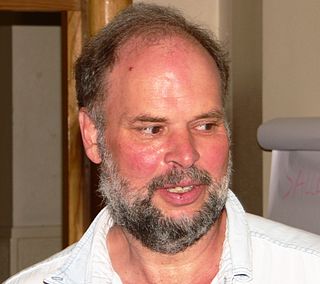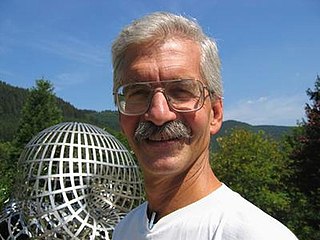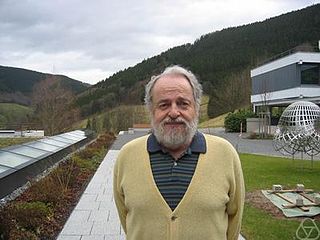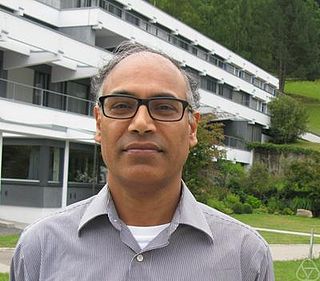Related Research Articles

Harold Scott MacDonald "Donald" Coxeter was a British-Canadian geometer and mathematician. He is regarded as one of the greatest geometers of the 20th century.

Sir Vaughan Frederick Randal Jones was a New Zealand mathematician known for his work on von Neumann algebras and knot polynomials. He was awarded a Fields Medal in 1990.

Nicholas Michael Katz is an American mathematician, working in arithmetic geometry, particularly on p-adic methods, monodromy and moduli problems, and number theory. He is currently a professor of Mathematics at Princeton University and an editor of the journal Annals of Mathematics.
The large sieve is a method in analytic number theory. It is a type of sieve where up to half of all residue classes of numbers are removed, as opposed to small sieves such as the Selberg sieve wherein only a few residue classes are removed. The method has been further heightened by the larger sieve which removes arbitrarily many residue classes.
In algebraic number theory, the prime ideal theorem is the number field generalization of the prime number theorem. It provides an asymptotic formula for counting the number of prime ideals of a number field K, with norm at most X.

David Eisenbud is an American mathematician. He is a professor of mathematics at the University of California, Berkeley and former director of the then Mathematical Sciences Research Institute (MSRI), now known as Simons Laufer Mathematical Sciences Institute (SLMath). He served as Director of MSRI from 1997 to 2007, and then again from 2013 to 2022.

Conjeevaram Srirangachari SeshadriFRS was an Indian mathematician. He was the founder and director-emeritus of the Chennai Mathematical Institute, and is known for his work in algebraic geometry. The Seshadri constant is named after him. He was also known for his collaboration with mathematician M. S. Narasimhan, for their proof of the Narasimhan–Seshadri theorem which proved the necessary conditions for stable vector bundles on a Riemann surface.
Henryk Iwaniec is a Polish-American mathematician, and since 1987 a professor at Rutgers University.

John Friedlander is a Canadian mathematician specializing in analytic number theory. He received his B.Sc. from the University of Toronto in 1965, an M.A. from the University of Waterloo in 1966, and a Ph.D. from Pennsylvania State University in 1972. He was a lecturer at M.I.T. in 1974–76, and has been on the faculty of the University of Toronto since 1977, where he served as Chair during 1987–91. He has also spent several years at the Institute for Advanced Study. In addition to his individual work, he has been notable for his collaborations with other well-known number theorists, including Enrico Bombieri, William Duke, Andrew Granville, and especially Henryk Iwaniec.

Chandrashekhar B. Khare is a professor of mathematics at the University of California Los Angeles. In 2005, he made a major advance in the field of Galois representations and number theory by proving the level 1 Serre conjecture, and later a proof of the full conjecture with Jean-Pierre Wintenberger. He has been on the Mathematical Sciences jury for the Infosys Prize from 2015, serving as Jury Chair from 2020.
In the field of number theory, the Brun sieve is a technique for estimating the size of "sifted sets" of positive integers which satisfy a set of conditions which are expressed by congruences. It was developed by Viggo Brun in 1915 and later generalized to the fundamental lemma of sieve theory by others.
The Coxeter-James Prize is a mathematics award given by the Canadian Mathematical Society (CMS) to recognize outstanding contributions to mathematics by young mathematicians in Canada. First presented in 1978, the prize is named after two renowned Canadian mathematicians, Donald Coxeter and Ralph James.

In number theory, the Selberg sieve is a technique for estimating the size of "sifted sets" of positive integers which satisfy a set of conditions which are expressed by congruences. It was developed by Atle Selberg in the 1940s.

In number theory, the Turán sieve is a technique for estimating the size of "sifted sets" of positive integers which satisfy a set of conditions which are expressed by congruences. It was developed by Pál Turán in 1934.
The Turán–Kubilius inequality is a mathematical theorem in probabilistic number theory. It is useful for proving results about the normal order of an arithmetic function. The theorem was proved in a special case in 1934 by Pál Turán and generalized in 1956 and 1964 by Jonas Kubilius.

Maciej Zworski is a Polish-Canadian mathematician, currently a professor of mathematics at the University of California, Berkeley. His mathematical interests include microlocal analysis, scattering theory, and partial differential equations.

Vijaya Kumar Murty is an Indo-Canadian mathematician working primarily in number theory. He is a professor at the University of Toronto and is the Director of the Fields Institute.
James Edward Humphreys was an American mathematician who worked in algebraic groups, Lie groups, and Lie algebras and applications of these mathematical structures. He is known as the author of several mathematical texts, such as Introduction to Lie Algebras and Representation Theory and Reflection Groups and Coxeter Groups.
Alina Carmen Cojocaru is a Romanian mathematician who works in number theory and is known for her research on elliptic curves, arithmetic geometry, and sieve theory. She is a professor of mathematics at the University of Illinois at Chicago and a researcher in the Institute of Mathematics of the Romanian Academy.

The Department of Mathematics and Statistics is an academic department at McGill University. It is located in Burnside Hall at McGill's downtown campus in Montreal.
References
- ↑ "Biographies of Candidates 2007" (PDF). Notices of the American Mathematical Society . 54 (8): 1043–1057. September 2007. Archived (PDF) from the original on 2 September 2009. Retrieved 25 May 2009.
- ↑ "Ram Murty's home page". Archived from the original on 21 January 2012. Retrieved 22 January 2012.
- ↑ Alex Michalos (editor), The Best Teacher I ever Had, Personal Reports from Highly Productive Scholars, The University of Western Ontario, London, 2003, 290p. ISBN 0-920354-53-X.
- ↑ Murty, M. Ram (2 June 2017). "How I Discovered Euclidean Proofs" (PDF). Retrieved 1 July 2022.
- ↑ M. Ram Murty at the Mathematics Genealogy Project
- ↑ "Faculty and Fellows at the Department of Philosophy of Queen's University" . Retrieved 1 July 2022.
- ↑ "Coxeter–James Prize". Canadian Mathematical Society . Retrieved 3 December 2021.
- ↑ "Membership". Royal Society of Canada. Archived from the original on 9 March 2012. Retrieved 10 October 2010.
- ↑ "INSA newsletter" (PDF). Indian National Science Academy (INSA). Archived from the original (PDF) on 24 October 2009. Retrieved 15 November 2010.
- ↑ List of Fellows of the American Mathematical Society Archived 2013-08-13 at the Wayback Machine , retrieved 2013-02-10.
- ↑ Thorne, Frank (2012). "Book Review: An introduction to sieve methods and their applications by Alina Carmen Cojocaru and M. Ram Murty and Opera de cribro by John Friedlander and Henryk Iwaniec". Bulletin of the American Mathematical Society. 50 (2): 359–366. doi: 10.1090/S0273-0979-2012-01390-3 . ISSN 0273-0979.